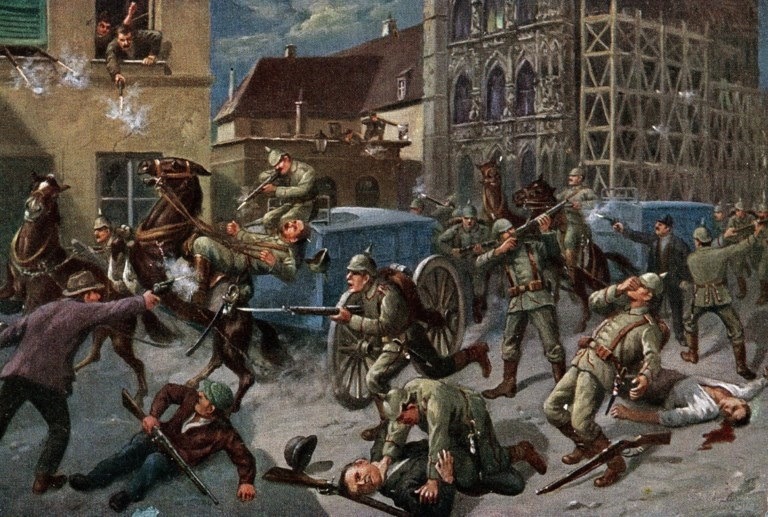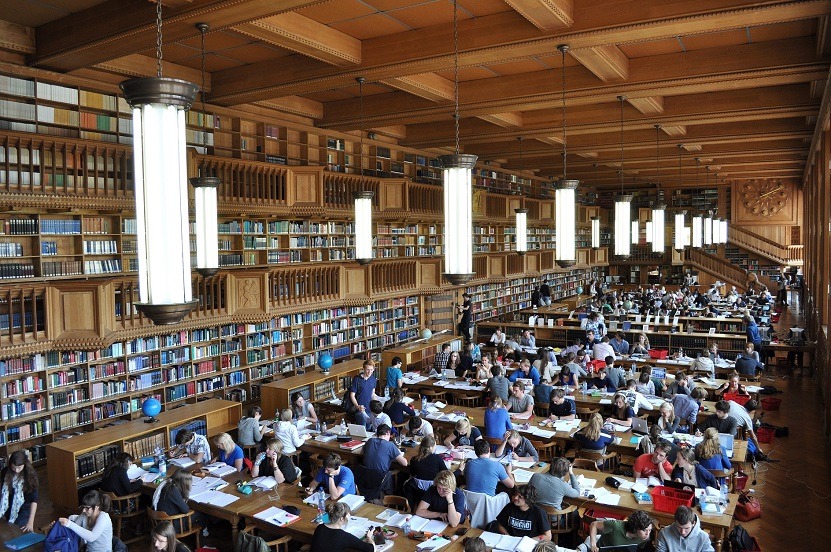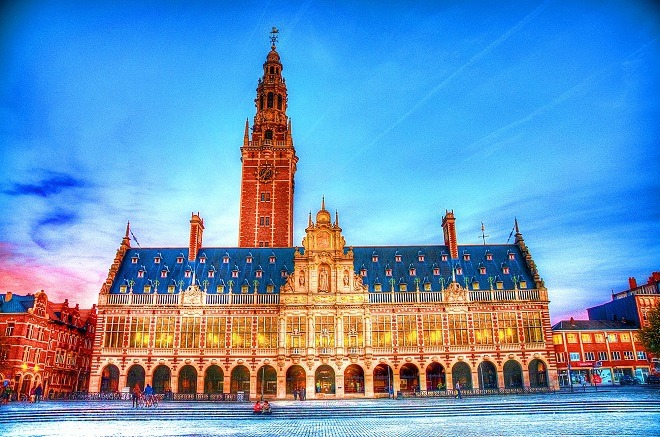Few libraries in the world have experienced such a dramatic history as the library of the university in Leuven (KU Leuven). Established only a few years after the founding of the university in 1425, it collected rare books and manuscripts over the centuries, only to lose them to France after the French revolution. But much worse was to come during the two world wars in 1914 and 1940.
The original university library building has been located since 1636 in the old cloth hall (currently the University Hall). During the First World War, German soldiers put fire to the building and its precious collections. After the war, a new library with a bell tower was built with American support, with a greater magnificence, and was almost turned into a war memorial.

The great hall of the of the old library in 1914, before it was destroyed.
The library was destroyed again directly after Nazi-Germany’s invasion of Belgium in the next world war and rebuilt brick by brick after the war as a sign of Leuven’s resilience and spirit. Today, the library is a modern humanities library, the main one in a complex of 24 university libraries and learning centres, which attracts both students and tourists.
The dramatic history started in 1795-1797 when thousands of books were confiscated and brought to France. Unlike the Grand Beguinage in Leuven, a kind of religious retreat for women that was dissolved after the French revolution, the library was not a religious institution but it belonged to a catholic university, which was closed down by the French revolutionaries.
The first destruction
“One of our professors is currently trying to locate the books in France,” says Hilde van Kiel, director of KU Leuven Libraries, but she is not optimistic about returning them to where they belong. We focused instead on the two calamities in the world wars. There is no doubt that the destruction of the library in WW1 was a wanton and deliberate act by the German army.
A permanent exhibition in the bell tower of the library building – admittedly coloured by Belgian patriotism – tells the tragic story that gave rise to German denials in the heat of the war and an outpouring of international solidarity with Belgium. A propaganda war, with cartoons and statements by intellectuals for and against militarism, started directly after the fire.

The burnt-out great hall of the old library in 1914. © Leuven University Archives
What happened then in Leuven seems to be, in retrospect, a warning about what would happen on a much larger scale during WW2. On 4 August 1914, Germany invaded neutral Belgium. In Leuven, a Belgian counterattack had come to a halt just before the town on 25 August. At dusk, German soldiers fired on each other in panic and blamed the shooting on civilians.
On the night of 25-26 August, German troops set fire to part of the town in retaliation for an alleged attack by snipers, according to the exhibition. “This was the beginning of terror that went into history as the sacking of Leuven. When the smoke cleared, it turned out that 2,000 buildings had been reduced to ashes and 248 civilians had been killed.”

On the night of 25-26 August 1914, German troops set Leuven on fire in retaliation for civilian resistance against their invasion. Half of the city was destroyed.
Leuven was subject to plundering and murder, writes journalist Jan van Impe in a booklet (2012) on the history of the library, which is for sale at the ticket office. Hundreds of civilians were deported to Germany in railway cattle cars. In the fire, around 300,000 books, 800 incunabula (books printed until 1500 in the first years after the invention of typographic printing) and 1,000 manuscripts were lost forever.

Leuven, 1914: Belgian citizens resisting German soldiers. © Ullstein Bild
The interwar period
As soon as the news spread about the destruction of the library, the outside world, especially the US, expressed solidarity with Leuven. An American committee was formed in 1918 after the end of the war, followed later by a relief committee for Belgium. They raised the necessary funding for the rebuilding, promising that donors would be immortalized by inscriptions on the walls.
The task to design the new library building was given to American architect Whitney Warren, known for the Grand Central Terminal in New York. The work took seven years (1921-1928) and was inspired by imaginary Flemish neo-renaissance architecture in an American style, says Van Kiel.
The new library, located next to Mgr. Ladueuzeplein at the highest point in the city centre, was meant to be become a display of friendship between the US and Belgium. This is still seen in the façade of the front of the building with plaques bearing the names of American universities and sculptures of the American eagle.

The main Library hall today. © KU Leuven Libraries
American presidents and their wives used to pay visits to the library and the American flag is still hoisted over the building every 4th of July. The current president has not visited the library yet, but it is a compulsory stop for any American tourist coming to Leuven. The other allied powers that defeated Germany are also represented by their national symbols.
The centre gable of the building is adorned with a four-and-a-half metre tall statue of a militant Madonna, surrounded by two saints slaying dragons, symbolizing evil. A visitor to the library today will be asked to start the tour with exiting the building to have a good look at the façade with all its symbols.
Destroyed and rebuilt for a second time
But the building today is not the original one reconstructed after WW1. After acquiring more than 900,000 volumes, the library suffered a new disaster in mid-May 1940, just a few days after Nazi Germany’s invasion of Belgium. Again the library was completely destroyed by fire and only 15,000 volumes survived the disaster.
Jan van Impe writes that the cause of the second fire continues to be a source of controversy until today. It might have been bombed by mistake by the Allies or deliberately destroyed by the Nazis, who saw it as an anti-German monument. Repairs started as soon as Belgium was liberated in 1944 and resulted in a new building modelled after the old one.
The main reading room, full with students and open to visitors, is 44 metres long and 13 metres wide, with two smaller reading rooms left and right. The room was completely destroyed in 1940, with the exception of the original American oak chairs, and had to be refurbished. Hilde van Kiel showed us a display of burned books, a reminder of the fires that destroyed the library twice.
The words of the German poet Heinrich Heine springs to mind: “Where they have burned books, they will end in burning human beings.”
The second main attraction for the visitor is the 74-metre tall bell tower. A model of the tower is found in the gallery on the ground floor. A winding spiral staircase, consisting of about 200 steps, brings the visitor to the top balcony where he/she is rewarded with an astonishing view of Leuven.
No wonder that Hilde van Kiel is proud of the library, a true jewel among the many KU Leuven Libraries. “It is a classical and still modern institution,” she summarizes. “The library is overcrowded with students and researchers, who appreciate the atmosphere in the reading room and come there for individual studies and research. Also the public can borrow books after registration.”
| Visiting the University Library Monseigneur Ladeuzeplein 21, 3000 Leuven Opening hours: Mondays to Fridays: 10 am - 7 pm Saturdays & Sundays: 10 am - 5 pm |
By Mose Apelblat

